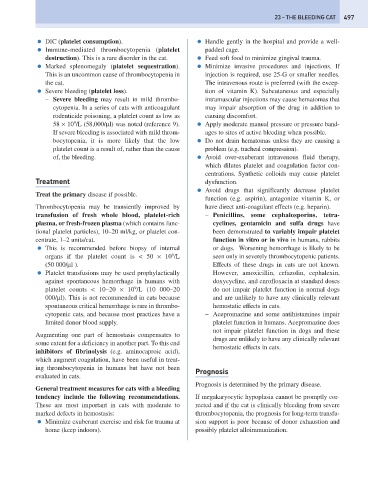Page 505 - Problem-Based Feline Medicine
P. 505
23 – THE BLEEDING CAT 497
● DIC (platelet consumption). ● Handle gently in the hospital and provide a well-
● Immune-mediated thrombocytopenia (platelet padded cage.
destruction). This is a rare disorder in the cat. ● Feed soft food to minimize gingival trauma.
● Marked splenomegaly (platelet sequestration). ● Minimize invasive procedures and injections. If
This is an uncommon cause of thrombocytopenia in injection is required, use 25-G or smaller needles.
the cat. The intravenous route is preferred (with the excep-
● Severe bleeding (platelet loss). tion of vitamin K). Subcutaneous and especially
– Severe bleeding may result in mild thrombo- intramuscular injections may cause hematomas that
cytopenia. In a series of cats with anticoagulant may impair absorption of the drug in addition to
rodenticide poisoning, a platelet count as low as causing discomfort.
9
58 × 10 /L (58,000/μl) was noted (reference 9). ● Apply moderate manual pressure or pressure band-
If severe bleeding is associated with mild throm- ages to sites of active bleeding when possible.
bocytopenia, it is more likely that the low ● Do not drain hematomas unless they are causing a
platelet count is a result of, rather than the cause problem (e.g. tracheal compression).
of, the bleeding. ● Avoid over-exuberant intravenous fluid therapy,
which dilutes platelet and coagulation factor con-
centrations. Synthetic colloids may cause platelet
Treatment dysfunction.
● Avoid drugs that significantly decrease platelet
Treat the primary disease if possible.
function (e.g. aspirin), antagonize vitamin K, or
Thrombocytopenia may be transiently improved by have direct anti-coagulant effects (e.g. heparin).
transfusion of fresh whole blood, platelet-rich – Penicillins, some cephalosporins, tetra-
plasma, or fresh-frozen plasma (which contains func- cyclines, gentamicin and sulfa drugs have
tional platelet particles), 10–20 ml/kg, or platelet con- been demonstrated to variably impair platelet
centrate, 1–2 units/cat. function in vitro or in vivo in humans, rabbits
● This is recommended before biopsy of internal or dogs. Worsening hemorrhage is likely to be
9
organs if the platelet count is < 50 × 10 /L seen only in severely thrombocytopenic patients.
(50 000/μl ). Effects of these drugs in cats are not known.
● Platelet transfusions may be used prophylactically However, amoxicillin, cefazolin, cephalexin,
against spontaneous hemorrhage in humans with doxycycline, and enrofloxacin at standard doses
9
platelet counts < 10–20 × 10 /L (10 000–20 do not impair platelet function in normal dogs
000/μl). This is not recommended in cats because and are unlikely to have any clinically relevant
spontaneous critical hemorrhage is rare in thrombo- hemostatic effects in cats.
cytopenic cats, and because most practices have a – Acepromazine and some antihistamines impair
limited donor blood supply. platelet function in humans. Acepromazine does
not impair platelet function in dogs and these
Augmenting one part of hemostasis compensates to
drugs are unlikely to have any clinically relevant
some extent for a deficiency in another part. To this end
hemostatic effects in cats.
inhibitors of fibrinolysis (e.g. aminocaproic acid),
which augment coagulation, have been useful in treat-
ing thrombocytopenia in humans but have not been
Prognosis
evaluated in cats.
Prognosis is determined by the primary disease.
General treatment measures for cats with a bleeding
tendency include the following recommendations. If megakaryocytic hypoplasia cannot be promptly cor-
These are most important in cats with moderate to rected and if the cat is clinically bleeding from severe
marked defects in hemostasis: thrombocytopenia, the prognosis for long-term transfu-
● Minimize exuberant exercise and risk for trauma at sion support is poor because of donor exhaustion and
home (keep indoors). possibly platelet alloimmunization.

